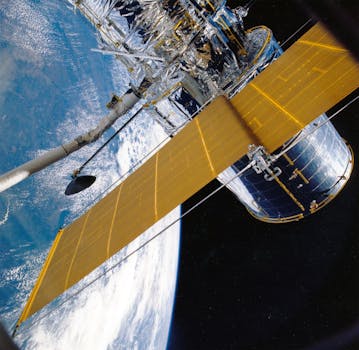From Geostationary to Low Earth Orbit: The Evolution of Satellite Telecommunications in 2023
The satellite telecommunications industry has undergone significant transformations in recent years, with a shift from geostationary to low Earth orbit satellites. This evolution has enabled faster and more reliable internet connectivity, paving the way for a new era in space technology.

From Geostationary to Low Earth Orbit: The Evolution of Satellite Telecommunications in 2023
From Geostationary to Low Earth Orbit: The Evolution of Satellite Telecommunications in 2023 has been a remarkable journey, marked by significant advancements in space technology. Satellite telecommunications have come a long way since the launch of the first geostationary satellite, Intelsat 1, in 1965. For decades, geostationary satellites have dominated the industry, providing a wide range of services, including television broadcasting, telecommunications, and weather forecasting. However, with the increasing demand for faster and more reliable internet connectivity, the industry has witnessed a shift towards low Earth orbit (LEO) satellites.
The geostationary orbit, located approximately 36,000 kilometers above the equator, has been the traditional hub for satellite telecommunications. Geostationary satellites have the advantage of remaining stationary in the sky, making it easier to maintain communication links. However, they have some significant limitations, including high latency and limited capacity. The high altitude of geostationary satellites results in a delay of around 250-300 milliseconds, which can be detrimental to real-time applications such as video conferencing and online gaming.
In recent years, the development of LEO satellites has revolutionized the satellite telecommunications industry. LEO satellites, which orbit the Earth at an altitude of around 160-2,000 kilometers, offer several advantages over their geostationary counterparts. They have lower latency, typically ranging from 20-50 milliseconds, making them suitable for real-time applications. Additionally, LEO satellites have higher capacity and can provide faster data transfer rates, making them ideal for applications such as broadband internet and IoT connectivity.
The Rise of LEO Satellites
The LEO satellite market has experienced rapid growth in recent years, driven by the increasing demand for faster and more reliable internet connectivity. Companies such as SpaceX, OneWeb, and Amazon’s Kuiper Systems are launching constellations of LEO satellites to provide global broadband internet coverage. These constellations, which can consist of hundreds or even thousands of satellites, are designed to provide low-latency and high-speed internet connectivity to remote and underserved areas.
The development of LEO satellites has also been driven by advancements in technology, including the use of advanced materials, propulsion systems, and electronic components. The miniaturization of satellite components has made it possible to build smaller and more efficient satellites, reducing the cost of launch and operation. Additionally, the development of reusable launch vehicles, such as SpaceX’s Falcon 9, has significantly reduced the cost of accessing space.
Challenges and Opportunities
While the shift towards LEO satellites presents several opportunities for the satellite telecommunications industry, it also poses some significant challenges. One of the major challenges is the management of a large constellation of satellites, which requires complex systems and protocols to ensure efficient operation and avoid collisions. Additionally, the launch and operation of a large number of satellites can result in increased space debris, which poses a risk to other satellites and spacecraft.
Despite these challenges, the LEO satellite market is expected to continue growing in the coming years, driven by the increasing demand for faster and more reliable internet connectivity. The development of LEO satellites has also created new opportunities for applications such as Earth observation, navigation, and scientific research. As the satellite telecommunications industry continues to evolve, it is likely that we will see the development of new technologies and innovations that will shape the future of space technology.
Conclusion
In conclusion, the evolution of satellite telecommunications from geostationary to low Earth orbit has been a significant development in the space technology industry. The shift towards LEO satellites has enabled faster and more reliable internet connectivity, paving the way for a new era in space technology. As the industry continues to evolve, it is likely that we will see the development of new technologies and innovations that will shape the future of satellite telecommunications.



